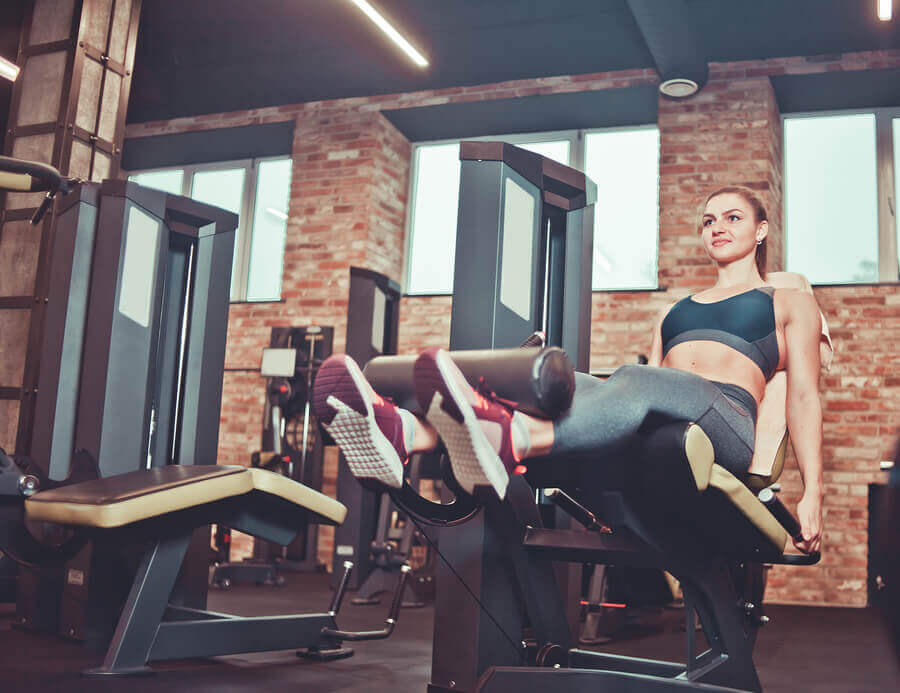Leg Extensions for Stronger Quadriceps

Leg extensions are one of the most efficient leg exercises around. They’re also simple to do and don’t require a great deal of technique. Their simplicity and efficiency means they’re perfect for people of all physical levels.
In our post today we want to walk through the correct steps of the exercise. In addition, we want to warn you about the most common mistakes people make when doing this exercise. Remember that exercising incorrectly isn’t only inefficient, but dangerous as well.
Benefits of doing leg extensions
Many people who exercise regularly include leg extensions in their routine because they have great results that help them develop even further in other sports or workouts.
At the gym, bodybuilders and regular gym-goers alike all use the leg extension machine. Without going too much into detail, this exercise offers these major benefits:
- Zero harm to joints: unlike other leg strengthening exercises, your knees won’t suffer from doing leg extension reps. It’s a great exercise option for people who suffer from knee problems because it doesn’t directly involve any other joint.
- Helps build quadriceps: this exercise really builds and strengthens the quadriceps.

Leg extensions: steps
Though it’s a relatively simple exercise to do, you should take the time to read how to do it correctly. Learning is the only way to exercise correctly and prevent injuries. Here are the steps:
- Choose an appropriate weight that’s suitable for you and your workout goals. Try asking a personal trainer if possible to help you make the best choice.
- Sit on the machine and place your feet on the lower bar. The bar should rest under your heels.
- Keep your legs parallel to each other and spread them apart as wide as your body is wide.
- Lean your back against the seat. Make sure the back of your neck is supported and that your head is looking straight forward.
- Grab the bottom of the chair to anchor your body.
- Once you’re ready, start extending your legs. Do the reps carefully and at the same pace throughout the sets. Take a couple of seconds to rest between your sets.
Common mistakes to avoid
As you read above, leg extensions don’t require too much technique. But, because they’re so easy, many people breeze through them without minding their position and movements. Sometimes we can be overly confident in our workouts when we’re actually making a crucial mistake.

Just as we said before, doing an exercise wrong doesn’t just prevent us from seeing good results; it can also increase our chances of suffering an injury.
Considering the risk, taking the time to follow the steps carefully is key. In addition, learning the most common mistakes will also help keep you safe:
- Curved back: you have to keep your back straight during the entire exercise. If your posture worsens with each rep, stop to readjust your posture, then continue. Stopping your exercise for a few seconds is no big deal. The machine comes with a seat back and all you have to do is fall back into it.
- Lifting hips: sometimes when people extend their legs, they raise their hips as well without even realizing it. It’s a dangerous action. Aside from robbing your legs from a workout, it forces another part of your body to work when it shouldn’t.
Lastly, the final mistake to look out for is overextending or bending. Instead of forcing your legs too much, let the machine guide your legs. The support bar under your heels will give you a natural indication of how much you should bend your knees. You won’t get a better workout just by extending your legs more than you have to.
Leg extensions are a great and efficient workout. They’re definitively a favorite for leg day!
Leg extensions are one of the most efficient leg exercises around. They’re also simple to do and don’t require a great deal of technique. Their simplicity and efficiency means they’re perfect for people of all physical levels.
In our post today we want to walk through the correct steps of the exercise. In addition, we want to warn you about the most common mistakes people make when doing this exercise. Remember that exercising incorrectly isn’t only inefficient, but dangerous as well.
Benefits of doing leg extensions
Many people who exercise regularly include leg extensions in their routine because they have great results that help them develop even further in other sports or workouts.
At the gym, bodybuilders and regular gym-goers alike all use the leg extension machine. Without going too much into detail, this exercise offers these major benefits:
- Zero harm to joints: unlike other leg strengthening exercises, your knees won’t suffer from doing leg extension reps. It’s a great exercise option for people who suffer from knee problems because it doesn’t directly involve any other joint.
- Helps build quadriceps: this exercise really builds and strengthens the quadriceps.

Leg extensions: steps
Though it’s a relatively simple exercise to do, you should take the time to read how to do it correctly. Learning is the only way to exercise correctly and prevent injuries. Here are the steps:
- Choose an appropriate weight that’s suitable for you and your workout goals. Try asking a personal trainer if possible to help you make the best choice.
- Sit on the machine and place your feet on the lower bar. The bar should rest under your heels.
- Keep your legs parallel to each other and spread them apart as wide as your body is wide.
- Lean your back against the seat. Make sure the back of your neck is supported and that your head is looking straight forward.
- Grab the bottom of the chair to anchor your body.
- Once you’re ready, start extending your legs. Do the reps carefully and at the same pace throughout the sets. Take a couple of seconds to rest between your sets.
Common mistakes to avoid
As you read above, leg extensions don’t require too much technique. But, because they’re so easy, many people breeze through them without minding their position and movements. Sometimes we can be overly confident in our workouts when we’re actually making a crucial mistake.

Just as we said before, doing an exercise wrong doesn’t just prevent us from seeing good results; it can also increase our chances of suffering an injury.
Considering the risk, taking the time to follow the steps carefully is key. In addition, learning the most common mistakes will also help keep you safe:
- Curved back: you have to keep your back straight during the entire exercise. If your posture worsens with each rep, stop to readjust your posture, then continue. Stopping your exercise for a few seconds is no big deal. The machine comes with a seat back and all you have to do is fall back into it.
- Lifting hips: sometimes when people extend their legs, they raise their hips as well without even realizing it. It’s a dangerous action. Aside from robbing your legs from a workout, it forces another part of your body to work when it shouldn’t.
Lastly, the final mistake to look out for is overextending or bending. Instead of forcing your legs too much, let the machine guide your legs. The support bar under your heels will give you a natural indication of how much you should bend your knees. You won’t get a better workout just by extending your legs more than you have to.
Leg extensions are a great and efficient workout. They’re definitively a favorite for leg day!
All cited sources were thoroughly reviewed by our team to ensure their quality, reliability, currency, and validity. The bibliography of this article was considered reliable and of academic or scientific accuracy.
- Cordero, A., Masiá, M. D., & Galve, E. (2014). Ejercicio físico y salud. Revista Española de Cardiología. https://doi.org/10.1016/j.recesp.2014.04.007
- Alfonso Blanco Nespereira. 1000 ejercicios de musculación. Editorial Paidotribo. http://egdf.com.ar/wp-content/uploads/2015/11/1000-ejercicios-de-musculacion-2.pdf
- Willson, J. D., Ireland, M. L., & Davis, I. (2006). Core strenght and lower extremity alignment during single leg squats. Medicine and Science in Sports and Exercise, 38(5), 945–952. https://doi.org/10.1249/01.mss.0000218140.05074.fa
This text is provided for informational purposes only and does not replace consultation with a professional. If in doubt, consult your specialist.








